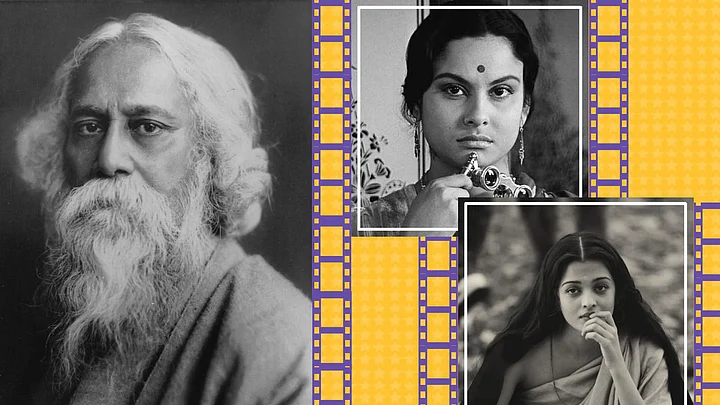Rabindranath Tagore, the man Bengalis are obsessively obsessed with, invites doubts from people who don’t understand the Bengali language. Every Tagore aficionado would vouch for the fact that his elegant writing comes as stilted in translations. Till we get translators who can do justice to the renaissance man, here’s is a simple trick to enter his world. The cinematic course.
On Gurudev’s death anniversary, watch the five adaptations to understand the man who can charm you with his writing.
Charulata
In the late 19th century Bengal, Charulata (Madhabi Mukherjee) spends her lonely hours reading and doing embroidery while her husband, Bhupati (Shailen Mukherjee), is too busy working for his nationalist magazine. Charu finds her companion in Bhupati’s cousin, Amal (Soumitra Chatterjee), which slowly blooms into creative enthusiasm, and finally love. Satyajit Ray adapting Tagore’s Nastaneer (The Broken Nest) breaks away from the original story a great deal. The novel which has descriptive passages of characters and situations finds itself compressed into wordless images of startling beauty, and the opening sequence of Charu looking through an opera glass is a prime example. By the time Bhupati sees Charu in her chamber of secrets, she has come of age, the most heartbroken way possible.
Kabuliwala
One of Tagore’s most widely read and admired short stories, the story gave birth to a terrific Bengali adaptation starring one of the stalwarts of Bengali cinema, Chhabi Biswas. In the Hindi version, Balraj Sahni portrays the Afghan dry fruit seller and his scenes with the little girl Mini glow with infinite tenderness. Sahni actually vanished from his house for a week, stayed with Afghani immigrants in Bombay to get into the skin of the character. And that effort shows. Manna Dey rendition of Aye mere pyaare watan can melt any migrant’s heart making a living in a city.
Chokher Bali
Adapting Tagore’s Chokher Bali albeit in a period setting, Bengali’s cinema’s enfant terrible, Rituporno Ghosh explores his favourite subject - lives behind closed doors. Aishwarya Rai channelises her restraint into her character Binodini, a widow who refuses to give in to the norms, and slowly subverts the system. Changing the end of Tagore’s novel, Ghosh overturns sexual politics to give us a heroine who refuses to be rescued by a man and a rare film exploring female gaze.
Char Adhyay
Kumar Shahani, not your typical Bollywood filmmaker, adapts Tagore’s political novel of the same name into a non-linear exploration of Ela, the heroine of the novel. Ela, being part of a group of revolutionaries slowly starts questioning blind patriotism mirroring Tagore’s departure from staunch nationalism in his writing. A great reflection of Tagore’s idea of woman and political worldview in this edition, Shahni’s signature visual style is a pleasant deviation from potboilers.
Do Bigha Zamin
Though the film is based on Salil Chowdhury’s story, it owes its name and the sense of sadness to Tagore’s long poem, Dui Bigha Jomi. It only altered the story by placing it in independent India embracing industrialisation. One of Hindi cinema’s definitive films, today’s audience may find Bimal Roy’s film a bit sentimental but the poignancy of the narrative is unquestionable. Balraj Sahni who taught at Tagore’s Shantiniketan before entering films plays Shambu Mahato with deep-seated humanism, a performance Tagore would have been proud of.
(The writer is a journalist and screenwriter who believes in the insanity of words, in print or otherwise)
(At The Quint, we question everything. Play an active role in shaping our journalism by becoming a member today.)
